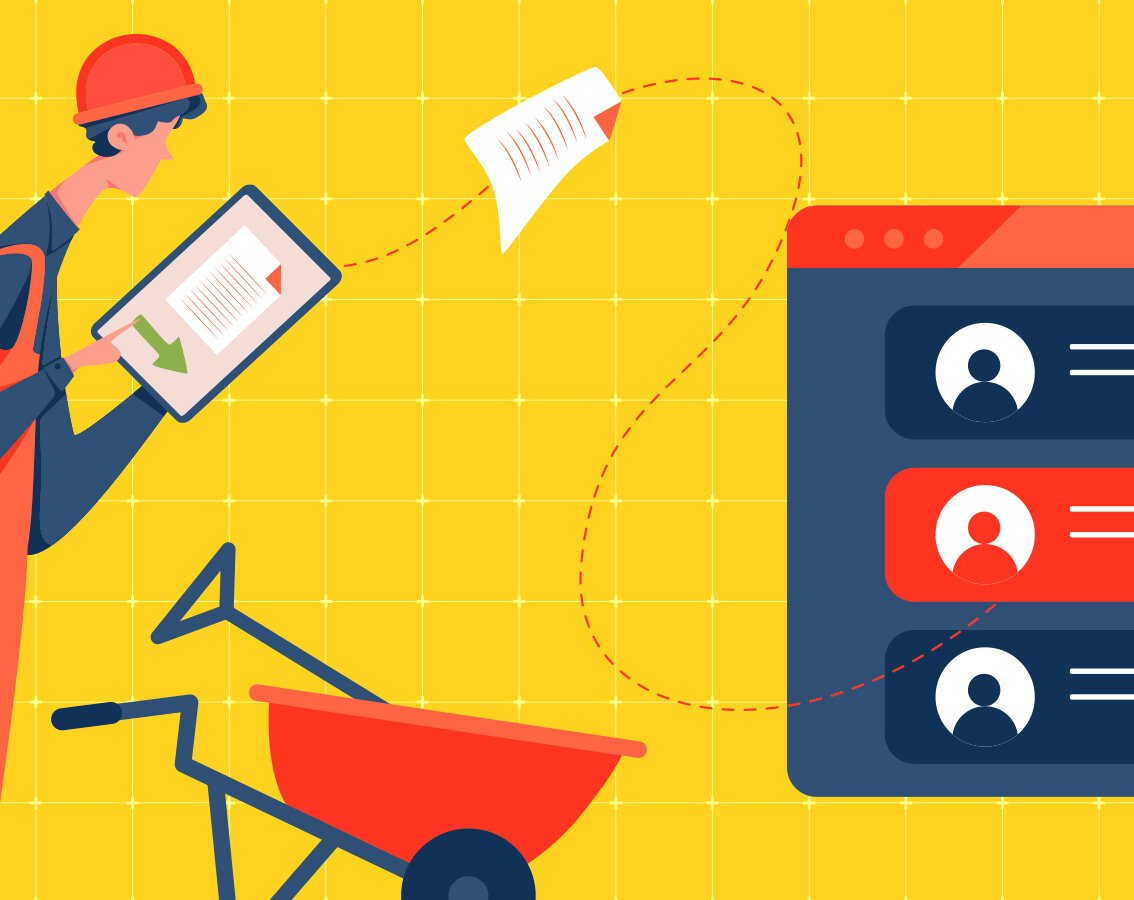blog
How Technology is Changing Construction Risk Management
By Mohan S Software development Digital transformation May 30, 2023

Construction has the highest rate of fatal injuries of any sector in the US, according to data from the Occupational Safety and Health Administration (OSHA). 1,006 fatalities occurred in the construction sector in 2020, making up 20.9% of all worker fatalities in that year. In 2020, falls accounted for 401 of the 401 fatalities among construction workers.
The wide range of risks in the construction industry can potentially have a substantial financial impact on businesses. The Bureau of Labor Statistics reports that in 2020, the fatal injury rate for the construction sector was 9.5 per 100,000 full-time equivalent employees, which is much higher than the national average of 3.5 per 100,000 full-time equivalent employees for all U.S.
Would you like to read how the construction industry is transforming in this decade?
The data and evidence show that, with a variety of possible risks and perils for workers and anyone involved in the construction process, the construction business is inherently risky. The most frequent risks in the construction industry include falls from great heights, being struck by objects that are falling, electrocution, and exposure to dangerous substances like asbestos and lead. Employers should address these concerns and take preventative measures to safeguard their employees. This can involve offering the proper training and tools, carrying out frequent safety inspections, and putting in place efficient safety rules and procedures.
6 Ways Technology Can Help Construction Sites Manage Risks and Disruptions
The risks involved in the construction industry can lead to cost overruns, delays, and lower-quality work. Fortunately, digital technologies can be used to mitigate these risks and disruptions in construction work. From preventing design errors to improving worker safety and reducing environmental impact, digital technologies are transforming the way construction sites operate. In this era of digital transformation, it is essential for construction companies to leverage these technologies to remain competitive and ensure the success of their projects.
Here are six ways technology can decrease the chances of risk in construction work. Read on.
1. Preventing design and planning errors
Technology can play a crucial role in helping construction sites manage risks and disruptions. By leveraging digital tools such as BIM, digital risk management software, and digital documents, construction teams can identify and address potential risks early in the process, reducing the likelihood of disruptions and delays during construction.
Digital documents in construction can come in various forms, but two common types are:
Construction Drawings: These are digital representations of the planned construction, usually in the form of 2D or 3D drawings, created by architects, engineers, and designers. These documents serve the purpose of providing a visual representation of the construction project and a clear reference point for the construction team to follow during the building process. Digital construction drawings can be easily updated and shared among project stakeholders, improving collaboration and reducing the risk of errors.
Specifications: Specifications are detailed documents that outline the materials, quality standards, and construction techniques that will be used during the construction process. These documents serve the purpose of providing a clear set of guidelines for the construction team to follow, ensuring that the project is built to the desired quality and safety standards. Digital specifications can be easily updated and shared, reducing the risk of miscommunication and errors during the construction process.
Digital documents such as construction drawings and specifications help construction sites manage risks and disruptions in several ways:
Accuracy: Digital documents are more accurate and up-to-date than paper documents, reducing the risk of errors and miscommunication.
Accessibility: Digital documents can be easily accessed and shared among project stakeholders, improving collaboration and reducing the risk of delays and disruptions.
Efficiency: Digital documents can be quickly updated and distributed, saving time and reducing the risk of delays.
Transparency: Digital documents provide a clear record of project decisions and changes, improving transparency and reducing the risk of disputes.
2. Avoiding cost overruns, delays, and delivering excellent quality
By offering real-time tracking and monitoring of many components of the construction project, a digital project management software, app, or platform can help construction sites manage risks and interruptions. Among other things, this can aid in enhancing supply chain management, teamwork, cost management, quality control, schedule management, and safety management. Construction sites can produce exceptional quality, prevent cost overruns, and minimize delays and interruptions by utilizing technology.
The following are some benefits of using a digital project management tool:
Supply Chain Management: Digital project management software can track and monitor goods and supplies in real-time to make sure they arrive on schedule and at the right place. By doing this, supply chain problems may be less likely to create delays and interruptions.
Collaboration: Digital project management software can help project stakeholders, such as architects, engineers, contractors, and subcontractors, collaborate more effectively. This can facilitate better communication, lessen the possibility of misunderstandings, and guarantee that everyone is on the same page.
Cost management: By keeping track of expenditures and delivering real-time budget updates, digital project management software can assist in cost management. This can aid in locating cost overruns and enabling real-time modifications.
Quality control: Digital project management software can provide real-time tracking and monitoring of quality control measures, including components, tools, and craftsmanship. As a result, problems can be found early on and quality requirements can be met throughout the construction process.
Schedule management: By monitoring development and spotting potential delays, digital project management software may help manage construction timetables. This could make it more likely that the project will be finished on schedule and under budget.
Safety management: With real-time recording and monitoring of safety data, such as injuries, near-misses, and safety violations, digital project management software can assist with safety management. This can aid in the early detection of potential safety hazards and enable the immediate implementation of corrective measures.
3. Preventing worker accidents
For workers, construction sites can be dangerous places with a high chance of accidents and injuries. Fortunately, there are digital solutions out there that can help increase the safety of construction workers. By enabling real-time tracking and monitoring of worker activity, equipment, and safety measures, digital technology can, in general, play a significant role in enhancing construction worker safety. Construction sites can use wearables, drones, VR, mobile apps, IoT sensors, and AR technology to identify potential safety hazards early on and take corrective action.
The following are some ways that digital technologies can be beneficial:
Wearables: By giving real-time information on worker location, vital signs, and other crucial safety parameters, wearables such as smart helmets, safety glasses, and vests can assist in increasing worker safety. This can aid in the early identification of potential safety issues and enable the quick implementation of corrective measures.
Would you like to read how DB Schenker used wearables to track the health of their employees? - Activity and Health Tracking for DB Shenker
Drones: Drones are useful for surveying construction sites and spotting potential dangers to workers' safety, such as shaky buildings or debris. Additionally, they can be used to keep an eye on employee behavior and make sure that safety procedures are being followed.
Virtual Reality (VR): With the help of VR technology, dangerous scenarios can be simulated and workers can receive practical safety training. This can lessen the likelihood of accidents and help personnel get ready for potential safety issues.
Mobile apps: Mobile apps can be used to deliver real-time updates on safety threats and other crucial safety metrics, as well as safety education and training to employees. This can make sure that workers always have access to crucial safety information.
IoT sensors: They can be used to check machinery and equipment for potential safety risks like overheating or malfunctions. This can aid in the early detection of potential safety hazards and enable the implementation of corrective measures prior to an accident.
Augmented Reality (AR): With AR technology, workers can receive real-time safety information and alerts, such as notifications of dangerous chemicals or hazardous conditions. Workers will be able to remain informed of any potential safety risks thanks to this.
4. Reducing downtime due equipment failures
Equipment failures can cause downtime on construction sites, which can lead to significant delays and cost overruns. To address this issue, digital technologies are being used to enhance equipment maintenance and reduce the risk of breakdowns. IoT technology may drastically reduce downtime brought on by malfunctioning equipment by providing real-time monitoring, predictive maintenance, remote repair, inventory management, equipment optimization, and data analytics. By utilizing IoT technologies, construction sites may decrease equipment downtime, lower cost overruns, and increase overall project efficiency.
Here are several instances when digital technologies, particularly IoT, can be advantageous:
Real-time monitoring: IoT sensors can be used for real-time monitoring of equipment, gathering data on its performance, and alerting maintenance personnel of any issues before they get out of hand.
Predictive maintenance: Predictive maintenance algorithms can forecast potential equipment failures by analyzing data from Internet of Things (IoT) sensors, allowing maintenance employees to take preventive action before a breakdown results in downtime.
Remote maintenance: IoT sensors can also be used to enable remote maintenance, which allows maintenance personnel to diagnose and address equipment issues from a distance. This can help reduce downtime by reducing the amount of time required for on-site repairs.
Inventory control: IoT sensors can be used to keep track of the stock of tools and replacement components, ensuring that service professionals have the equipment they need to solve issues quickly and effectively.
Equipment Optimization: Thanks to IoT sensors' capacity to gather information on usage and performance, equipment settings and operations can be improved to save wear and tear and lengthen their lifespan.
Data analytics: Building sites can discover more about how their equipment is used, identify areas that could use improvement, and streamline maintenance procedures by analyzing data from IoT sensors and other sources.
5. Reducing environmental impact
The construction sector uses a lot of resources and can have a big effect on the environment. Digital technologies are, however, being used to promote sustainability in construction operations and lessen the environmental impact of the sector. Digital technologies have a significant impact on how much of an environmental impact building work has. Construction sites can increase sustainability and reduce their environmental impact by utilizing BIM, energy management systems, smart building technology, sustainable materials, waste management, and green building certifications.
Building Information Modeling (BIM): By using BIM software to produce digital models of infrastructure and buildings, it is possible to more effectively plan, build, and run buildings. BIM can help minimize the environmental impact of construction projects by improving designs and cutting waste.
Energy management systems: Digital energy management systems can be used to monitor and optimize how much energy is consumed in infrastructure and buildings. This may aid in lowering greenhouse gas emissions and energy use.
Smart Building Technologies: By utilizing automated lighting and HVAC systems, one can maximize energy efficiency and cut down on waste. Smart building technologies can help cut energy consumption and lower environmental impacts by changing systems based on occupancy and other factors.
Sustainable Materials: For construction projects, sustainable materials can be found and sourced using digital technologies. Construction sites can make better decisions and lessen their environmental impact by analyzing data on materials and their environmental impact.
Waste Management: By utilizing digital technologies, waste management on building sites can be enhanced. Construction sites can find possibilities to minimize waste and improve recycling, reducing their environmental impact. This is done by tracking trash and recycling data.
Green building certifications: Using digital technology, compliance with green building certifications like LEED and BREEAM can be tracked and verified. These certifications can promote sustainability in construction projects by guaranteeing that structures and infrastructure adhere to stringent sustainability criteria.
6. Simplifying regulatory compliance
Regulations must be followed throughout construction work because failure to do so could result in fines, legal action, and damage to a company's reputation. However, keeping up with the regulations can be challenging given how frequently they change. Thankfully, the use of digital technologies has made it simpler for construction employees to follow rules. Digital technologies can greatly simplify regulatory compliance in the construction industry. Construction businesses can expedite compliance operations and make sure they are complying with regulations by utilizing electronic document management, compliance tracking, training and education, automated reporting, and data analytics.
Following are some examples of how digital technologies might be useful:
Electronic Document Management: Electronic document management systems can be used to store and organize papers, making it easier to access and update regulatory documentation as needed. This can guarantee that those who need it get access to the most recent data.
Compliance tracking: Digital technology can be used to track a company's compliance with regulations and highlight any areas where they may be falling short. You can make sure that firms are aware of any compliance issues and ready to address them by doing this.
Digital technology can be used by employers to train and inform staff members about regulatory compliance. This can guarantee that employees understand the regulations and how to abide by them.
Automated Reporting: By automating regulatory compliance reporting, time and resources can be saved on report preparation. Due to this, reports may be submitted on time, accurately, and with up-to-date information.
Data analytics: Digital technology can assist businesses in identifying trends and areas for development by analyzing data on regulatory compliance. This can assist businesses in proactively addressing compliance issues and enhancing compliance generally.
Conclusion
Technology can help avoid risks in construction in several ways. From using Building Information Modeling (BIM) to identify potential problems early in the design phase to using. Drones and other remote monitoring technology can be used to inspect construction sites for potential hazards or safety risks.
Technology such as real-time project management software can help ensure that projects stay on track and that issues are identified and addressed in a timely manner, reducing the risk of delays and cost overruns, helping construction companies to reach new heights of success.



